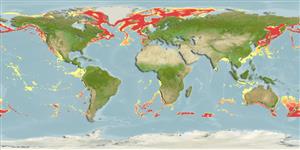ກຸ່ມປາກະດູກອ່ອນ (ເຊັ່ນ: ປາສະຫລາມ, ປາຜາໄລ) (sharks and rays) >
Rajiformes (Skates and rays) >
Rajidae (Skates)
Etymology: Amblyraja: Greek, amblys = darkness + Latin, raja, -ae = ray (Raja sp.) (Ref. 45335).
Environment: milieu / climate zone / depth range / distribution range
ນິເວດວິທະຍາ
ສັດທະເລ ກ່ຽວກັບ(ຢູ່)ຊັ້ນນ້ຳໃນທະເລທີ່ເໜີອພື້ນດິນ; ລະດັບຄວາມເລິກ 92 - 2925 m (Ref. 119696), usually 300 - 2300 m (Ref. 9261). Deep-water; -1°C - 4°C (Ref. 119696); 82°N - 50°S, 180°W - 180°E
Arctic, Indian, Pacific and Atlantic oceans: in cold and deep waters.
Length at first maturity / ຂະໜາດ / ນ້ຳໜັກ / Age
Maturity: Lm ?, range 94 - ? cm
Max length : 112 cm TL ຕົວຜູ້/ບໍ່ມີເພດ; (Ref. 114953); 100.0 cm TL (female)
Short description
ຕົວທີ່ໃຊ້ໃນການຈຳແນກຊະນິດ | ສະລີລະວິທະຍາ | ການວັດແທກຮູບຮ່າງລັກສະນະພາຍນອກຂອງດິນ,ສັດ,ປາ…
Grey-brown with large dark blotches (Ref. 26346). Tail very short (Ref. 26346). Mid-dorsal row of stout thorns which extend from nuchal region to first dorsal fin. Thorns close posterior to the pelvic girdle larger than along the tail (Ref. 6902). Upper surface dark mouse gray, dark blue gray or dark brown with small rounded spots. Lower surface white and sooty in variable patterns (Ref. 6902).
Found on the lower continental slope (Ref. 6871), probably most common on deep slopes and at abyssal depths (Ref. 114953). Benthic (Ref. 58426); meso- to bathybenthic, on muddy substrate (Ref. 119696). Adults feed on all kinds of bottom animals (Ref. 3167). Prefer polar temperatures from hatching to maturity and eggs are incubated successfully and regularly in water as cold as 0°C (Ref. 6902). Oviparous. Distinct pairing with embrace. Young may tend to follow large objects, such as their mother (Ref. 205). Eggs are oblong capsules with stiff pointed horns at the corners deposited in sandy or muddy flats (Ref. 205). Egg capsule measures 81-125 mm long and 50-80 mm wide (Ref. 41251). Hatching size at 16-18 cm TL (Ref. 114953) (15 cm long in Ref. 119696).
Life cycle and mating behavior
ການຈະເລີນເຕັມໄວ | ການສືບພັນ | ການວາງໄຂ່ | ໄຂ່ | ຄວາມດົກຂອງໄຂ່ປາ | ຕົວອ່ອນ
Oviparous, paired eggs are laid. Embryos feed solely on yolk (Ref. 50449). Distinct pairing with embrace. Young may tend to follow large objects, such as their mother (Ref. 205).
McEachran, J.D. and K.A. Dunn, 1998. Phylogenetic analysis of skates, a morphologically conservative clade of elasmobranchs (Chondrichthyes: Rajidae). Copeia 1998(2):271-290. (Ref. 27314)
IUCN Red List Status (Ref. 130435: Version 2024-1)
Threat to humans
Harmless
Human uses
ການປະມົງ: ທີ່ບໍ່ມີຄວາມສົນໃຈ
ເຄື່ອງມື
Special reports
Download XML
ແຫຼ່ງອີນເຕີເນັດ
Estimates based on models
Preferred temperature (Ref.
123201): 0.3 - 8.8, mean 3.3 °C (based on 3242 cells).
Phylogenetic diversity index (Ref.
82804): PD
50 = 0.5010 [Uniqueness, from 0.5 = low to 2.0 = high].
Bayesian length-weight: a=0.00302 (0.00141 - 0.00645), b=3.24 (3.07 - 3.41), in cm total length, based on LWR estimates for this (Sub)family-body shape (Ref.
93245).
ຊັ້ນເຂດຮ້ອນ (Ref.
69278): 4.3 ±0.5 se; based on diet studies.
ຄວາມຢືດຢຸ່ນ (Ref.
120179): ຕຳ່, ປະຊາກອນຕຳ່ສຸດທີ່ໃຊ້ເວລາສອງເທົ່າ 4.5 - 14 ປີ (Fec assumed to be <100).
Fishing Vulnerability (Ref.
59153): High to very high vulnerability (67 of 100).
Climate Vulnerability (Ref.
125649): Moderate vulnerability (38 of 100).
Nutrients (Ref.
124155): Calcium = 3.31 [0.50, 67.94] mg/100g; Iron = 0.302 [0.029, 4.121] mg/100g; Protein = 15.3 [13.3, 17.3] %; Omega3 = 0.494 [0.199, 1.207] g/100g; Selenium = 20.6 [3.6, 97.8] μg/100g; VitaminA = 6.37 [0.45, 85.10] μg/100g; Zinc = 0.206 [0.013, 2.410] mg/100g (wet weight);
